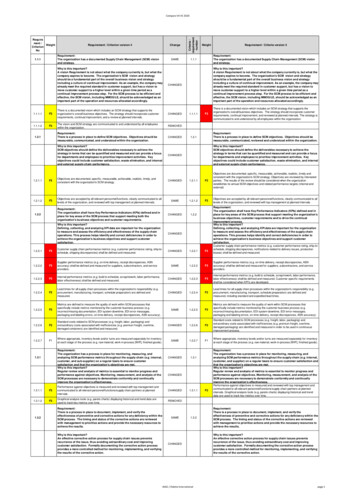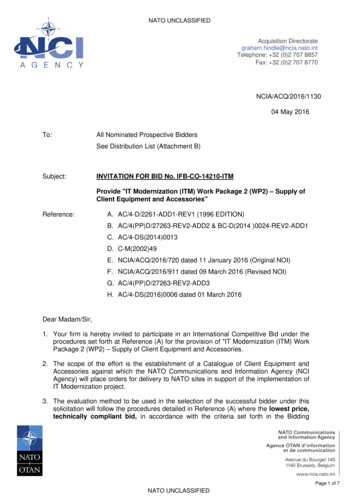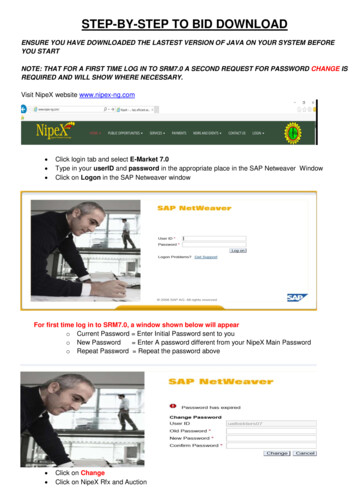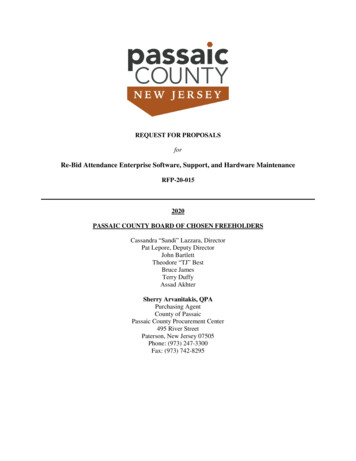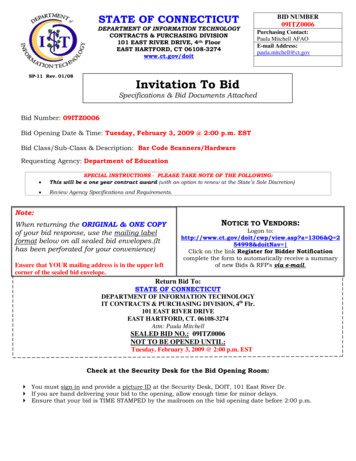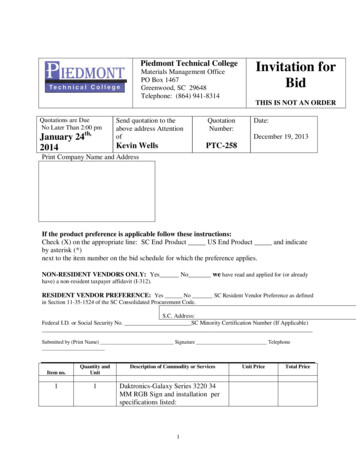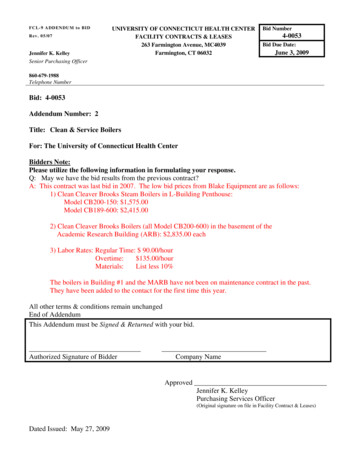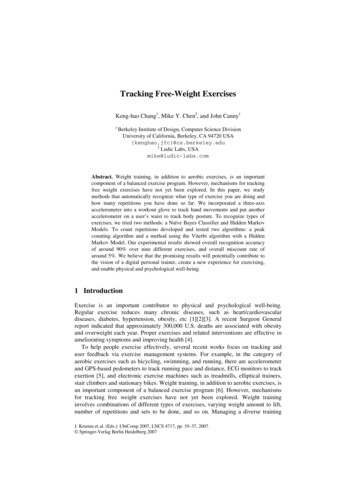
Transcription
Tracking Free-Weight ExercisesKeng-hao Chang1, Mike Y. Chen2, and John Canny11Berkeley Institute of Design, Computer Science DivisionUniversity of California, Berkeley, CA 94720 USA{kenghao,jfc}@cs.berkeley.edu2Ludic Labs, USAmike@ludic-labs.comAbstract. Weight training, in addition to aerobic exercises, is an importantcomponent of a balanced exercise program. However, mechanisms for trackingfree weight exercises have not yet been explored. In this paper, we studymethods that automatically recognize what type of exercise you are doing andhow many repetitions you have done so far. We incorporated a three-axisaccelerometer into a workout glove to track hand movements and put anotheraccelerometer on a user’s waist to track body posture. To recognize types ofexercises, we tried two methods: a Naïve Bayes Classifier and Hidden MarkovModels. To count repetitions developed and tested two algorithms: a peakcounting algorithm and a method using the Viterbi algorithm with a HiddenMarkov Model. Our experimental results showed overall recognition accuracyof around 90% over nine different exercises, and overall miscount rate ofaround 5%. We believe that the promising results will potentially contribute tothe vision of a digital personal trainer, create a new experience for exercising,and enable physical and psychological well-being.1 IntroductionExercise is an important contributor to physical and psychological well-being.Regular exercise reduces many chronic diseases, such as heart/cardiovasculardiseases, diabetes, hypertension, obesity, etc [1][2][3]. A recent Surgeon Generalreport indicated that approximately 300,000 U.S. deaths are associated with obesityand overweight each year. Proper exercises and related interventions are effective inameliorating symptoms and improving health [4].To help people exercise effectively, several recent works focus on tracking anduser feedback via exercise management systems. For example, in the category ofaerobic exercises such as bicycling, swimming, and running, there are accelerometerand GPS-based pedometers to track running pace and distance, ECG monitors to trackexertion [5], and electronic exercise machines such as treadmills, elliptical trainers,stair climbers and stationary bikes. Weight training, in addition to aerobic exercises, isan important component of a balanced exercise program [6]. However, mechanismsfor tracking free weight exercises have not yet been explored. Weight traininginvolves combinations of different types of exercises, varying weight amount to lift,number of repetitions and sets to be done, and so on. Managing a diverse trainingJ. Krumm et al. (Eds.): UbiComp 2007, LNCS 4717, pp. 19–37, 2007. Springer-Verlag Berlin Heidelberg 2007
20K.-h. Chang, M.Y. Chen, and J. Cannysequence should be well supported on site. During the process of working out, peoplemay forget their progress, skip steps, or miscount a sequence. Even though peoplemay try to organize by keeping notes on their progress, this is tedious and easily turnsthe workout into a chore.We are exploring several applications in weight exercise management. The first isan exercise tracker: a system which automatically keeps track of your progress of freeweight exercises. You only have to focus on doing the exercises without worryingabout remembering your progress. It can be accessed anytime, anywhere: this systemis embedded in the mobile device that you normally bring with you when you walkinto a gym, illustrated in Fig. 1. You can check it before, during, or after your trainingprocess. The second application is an exercise planner: you can review your exercisehistory from the mobile device and this system can help you design a proper exerciseplan. Eventually we would like to build a digital personal trainer: it warns you if youexercise too hard or in incorrect form.Fig. 1. Scenario of an exercise trackerThis paper focuses on exercise tracking: it explores methods that automaticallyrecognize what type of exercise you are doing and how many repetitions you havedone so far. In fact, recognizing exercise types belongs to the area of activityrecognition, which has been extensively explored in the past few years. In this work,we applied some well-studied methods and found that these methods can also achievegood results in our application. We first incorporated a three-axis accelerometer into aworkout glove to track hand movements, and put another accelerometer on a user’swaist to track body posture. We investigated the effectiveness of two methods torecognize exercise type: Naïve Bayes Classifiers and Hidden Markov Models. Inaddition, since the number of repetitions is another important factor of weighttraining, merely recognizing types of exercises is insufficient for an exercise tracker.So, we developed and tested two methods to count repetitions: a peak countingalgorithm and a method using the state sequence predicted by Hidden MarkovModels.Experimental results proved that the methods can be applied to a variety ofexercises, users, and conditions. For the exercise recognition goal, it achieved 95%accuracy based on single user data, and the accuracy was around 85% when we crossvalidated training results with new user data. For the counting goal, both proposedmethods achieved around 5% miscount rate in general, which means if a userperforms 100 repetitions, the system may miscount by less than 5 repetitions. Theexperimental results were based on exercise data we collected by asking ten subjects
Tracking Free-Weight Exercises21to perform nine different exercises, with different weight settings. The total length ofthe data was 9740 seconds (162.5 minutes), with a total of 4925 repetitions.The remainder of this paper is organized as follows. Section 1 describes the relatedwork. Section 2 describes a taxonomy of exercises and the rationale for usingaccelerometers to approach free weight exercises. Section 3 presents the developmentand evaluation of the algorithms. Finally, Section 4 states our future work andconclusions.2 Related WorkThe related work is categorized into the following two categories: exercise-specificwork and studies of activity recognition. In the first category, FitLinxx [7] usedsensors to track the usage of weight machines and showed training progress on abuilt-in display. Nonetheless, their sensors and tracking methods cannot be directlyapplied to free weight exercises, since FitLinxx only tracks predefined exerciseroutines on specific machines, and cannot perform the initial identification of type. Inaddition, iPod Nike [8] tracked jogging and used music feedbacks to promote a newexercise experience. In fact, both products promote the idea of a digital personaltrainer to coach exercise. As for research projects, House n [9] is building a system torecognize gym- and exercise-related activities with accelerometers. They also intendto better estimate calorie expenditure in real time, which is different from our goal oftracking and eventually creating a digital personal trainer for free weight exercises.In the category of activity recognition, there have been a large number of studiesusing different sensors, including accelerometers, gyroscopes, microphones,barometers, RFID readers, and GPS units, to recognize a variety of activities, andthose studies use a variety of different machine learning techniques. Rather thandeveloping brand new techniques, we applied and extended existing work to test theapplicability within this new domain. For example, Mithil [10] and House n [11]have shown great success using accelerometers to recognize activities such aswalking, running, bicycling, etc, so we adopted their methods in which a Naïve BayesClassifier was used to classify features extracted from sliding windows. We furtherleverage the characteristics of free weight exercise. For example, we only usedaccelerometers, rather than using both accelerometers and gyroscopes as in Minnen’swork [12]. The design choice was based on the observation that sensors attached andconstrained to gloves should be rotated with less degree of freedom in compare tobeing rotated freely in the air with no constraint (i.e. fixed on hands) and using onlyaccelerometers is sufficient. The gravity effect on accelerometers was thereforeemphasized and extracted as an extra feature. In fact, both their and our approachesachieved comparable 80 90% recognition accuracy. Hidden Markov Models havebeen widely applied. For example, Ward [13] and Georgia Tech Gesture Toolkit [14]applied HMMs to acceleration data. Moreover, Benbasat [15] identified aforward/backward (or a combination of both) hand movement as an atom, and theyregarded a gesture as a composition of gesture atoms. Similarly, we identified“atoms” in acceleration data to count repetitions with two different approaches.More techniques were proposed to contribute to the area of activity recognition.Minnen [12] made an unsupervised learning technique to avoid labeling effort. They
22K.-h. Chang, M.Y. Chen, and J. Cannyfirst used information theory to identify best motifs, and then, they applied HMM tolearn motif sets, which is exactly what we applied to our work. Wynatt [16] andHamid [17] also proposed similar methods. In addition, Lester [18] applied theAdaBoost technique to let algorithms selecting best set of features, which is differentfrom traditional approaches and what we did in this work to tune features manually.As for the settings in evaluation, we applied methods to recognize sets in isolation,rather than to recognize the entire exercise session. In future work, we would addressthis harder setup, as those by Lester[16], Ward[13], and Subramanya [19].3 Approaching Free Weight Exercises with AccelerometersThis paper addresses two goals. The first recognition goal is to detect what type ofexercise a user is doing. The second counting goal is to count how many repetitionsshe has been performing so far. To approach them, we provide a taxonomy of freeweight exercises, discuss the accelerometer-based approach, and provide rationale anddeployment details.3.1 The Taxonomy of Free Weight ExercisesTo fulfill the goals, we have identified the most common, representative free weightexercises in the gym environment in Table 1. Each exercise listed here is common andrepresentative in a sense that people frequently use those exercises to train eachindividual muscle group in the human body [20]. Exercises are listed based on themuscle groups they are designed to train. For example, to train the arms, people oftenperform bicep curls for biceps and tricep curls for triceps. To train the upper body,users perform bench press and flye to work on their chest muscles. They also performbent-over row to strengthen their upper backs, and use lateral raise to train shouldermuscles. Finally, in the lower body category, people use deadlift to train quadricepsand standing calf raise to train calves. Table 1 also lists the posture required toperform each exercise. The details of how to perform each free weight exercise canbe found in reference [21], and some of the exercises will be explained in section 2.2and section 2.3. We regard these exercises as the targets of our paper and we want toTable 1. Representaive and commonly performed exercises for each muscle group123456789ExerciseBiceps curlTricep curlBench pressFlyeBent-over rowLateral raiseOverhead dumbbell pressDeadliftStanding calf raisesMuscle groupsBicepsTricepsBody partArmsChestUpper backUpper BodyShouldersQuadricepsCalvesLower g
Tracking Free-Weight Exercises23figure out whether it is possible to track them well. Throughout this paper, thesecommonly performed exercises are used as examples to explain our work and asbaselines to test our system, in order to prove that our system is applicable to realworld gym environments.3.2 The Accelerometer Glove and the Posture ClipTo track the various free weight exercises listed in Table 1, we use accelerometers andincorporated acceleration data with machine learning techniques. Since in free weightexercises people hold and move weights, shown in Fig. 3, we instrumented a three-axisaccelerometer onto a workout glove on the right hand, shown in Fig. 2-(a). We say thissetting is applicable because people usually wear workout gloves when they performfree weight exercises. We call it the accelerometer glove throughout this paper. Thethree-axis accelerometer used is an off-the-shelf product, called WiTilt v2.5 by SparkFun Electronics [22]. WiTilt v2.5 employs a FreeScale MMA7260Q triple-axisaccelerometer. The accelerometer samples acceleration at a frequency of 80 Hz and inthe range of /- 1.5g. In addition, WiTilt v2.5 has Bluetooth wireless connectivity.zxy(a)y(b)Fig. 2. (a) The accelerometer glove and the directions of three axes on the accelerometer. Thez-axis is vertical to the palm. (b) The posture clip.In addition to hand movements, it is also important to differentiate whether peopleare standing or lying on a bench. For example in Fig.3, the hand movement of theoverhead dumbbell press is quite similar with the hand movements of bench press, inthat people push free weights straight up to the air in both cases. But these twoexercises are essentially different because the posture of lying down makes chestmuscles to be trained in bench press, while standing/sitting helps training shouldermuscles in the overhead dumbbell press. Therefore, we use a complementary postureclip to detect postures during exercises, shown in Fig. 2-(b). The posture clip is alsomade of a WiTilt v2.5 three-axis accelerometer.Considering the trade-off between accuracy, cost, and the nature of exercisesthemselves, we claim that it is sufficient to use only accelerometers to track freeweight exercises. Although accelerometers are much less expensive and much smallerthan Inertia Measurement Systems [23], three-axis accelerometers cannot tra
Tracking Free-Weight Exercises Keng-hao Chang1, Mike Y. Chen2, and John Canny1 1 Berkeley Institute of Design, Computer Science Division University of California, Berkeley, CA 94720 USA {kenghao,jfc}@cs.berkeley.edu 2 Ludic Labs, USA mike@ludic-labs.com Abstract. Weight training, in addition to aerobic exercises, is an important
